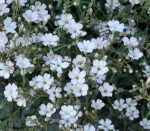 Creeping baby’s breath is a herbaceous perennial native the mountains of central and southern Europe where it grows on dry, chalky slopes. It is a member of the carnation family, Caryophyllaceae, that also includes pinks (Dianthus), soapwort, and Lychnis. The trailing eighteen inch long stems with gray leaves ½-1 inch long form substantial mats in about two years. Small open flat clusters of star-shaped ¼” flowers are white to pale lilac and cover the plant in summer. Plants are more tolerant of acid soils than their more famous cousin, florist’s baby’s breath (Gypsophila paniculata) and tolerate heat but not wet feet. They are especially attractive tumbling down walls and over large rocks, and are an excellent choice for use as an edging, ground cover, or container as well as for alpine and rock gardens. The generic name Gypsophila comes from the Greek words gypsos meaning gypsum and philos meaning loving, referring to the fact some species thrive only in limey. The specific epithet repens comes from the Latin word repto meaning to crawl or creep, describing the habit of the plant.
Creeping baby’s breath is a herbaceous perennial native the mountains of central and southern Europe where it grows on dry, chalky slopes. It is a member of the carnation family, Caryophyllaceae, that also includes pinks (Dianthus), soapwort, and Lychnis. The trailing eighteen inch long stems with gray leaves ½-1 inch long form substantial mats in about two years. Small open flat clusters of star-shaped ¼” flowers are white to pale lilac and cover the plant in summer. Plants are more tolerant of acid soils than their more famous cousin, florist’s baby’s breath (Gypsophila paniculata) and tolerate heat but not wet feet. They are especially attractive tumbling down walls and over large rocks, and are an excellent choice for use as an edging, ground cover, or container as well as for alpine and rock gardens. The generic name Gypsophila comes from the Greek words gypsos meaning gypsum and philos meaning loving, referring to the fact some species thrive only in limey. The specific epithet repens comes from the Latin word repto meaning to crawl or creep, describing the habit of the plant.
Type: Herbaceous perennial
Type: Herbaceous perennial
Bloom: White to pink single flowers ¼” across in early summer
Foliage: Narrow blue-gray leaves ½-1” long
Size: 4-8” H x 12” W
Light: Full sun
Soil: Average, well-drained, neutral to slightly alkaline but tolerates some acidity.
Hardiness: Zones 3-8
Care: Low maintenance; cut back to the crown in late winter to tidy up the garden (optional)
Pests and Diseases: None of significance
Propagation: Seed (do not cover); division in summer; cuttings of nonflowering terminal stems summer to fall
Companion plants: Campanula, lavender, ornamental grasses such as Festuca sp.
Outstanding Selections:
-
- ‘Alba’ (white flowers)
- ‘Rosea’ (pale pink flowers).
